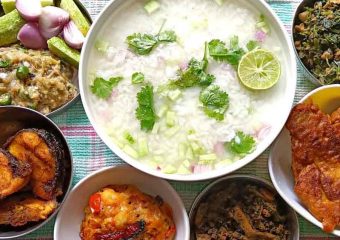Pakhaḷa (Odia: ପଖାଳ) an oriya expression for an Indian food in which cooked rice is washed or gradually grown in water. The fluid part is known as toraṇi. It is mainstream in Odisha, West Bengal, Jharkhand, Assam, Chhattisgarh, and Tamil Nadu.
In Tamil Nadu it is called Pazhaiya Sadam. The Bengali name for this dish is panta bhat, in Chhattisgarh it’s called bore bhat, in Jharkhand semantic networks use names like paani bhat, paakhaal or pakhala, and in Assam it’s called poita bhat.
It is a readiness that is had during summer, albeit numerous families and networks eat it consistently, particularly for lunch. Individuals who work in the sun, for example, ranch hands have it as it recharges the salt and water lost by the body.
A customary Odia dish, it is set up with rice, curd, cucumber, cumin seeds, singed onions and mint leaves. It is prominently presented with dry cooked vegetables—like potato, brinjal, badi and adventure bhaja or seared fish.
Historical background
The expression “pakhala” is gotten from Pali word “pakhaleiba” (Odia: ପଖାଳିବା, romanized: ପଖଳେଇବା) just as Sanskrit word “Prakshāḷaṇa” (Sanskrit: प्रक्षाळन) which signifies “washed/to wash.” The word pakhaḷa was utilized in the Odia sonnets of Arjuna Das in his scholarly work Kaḷpalata (1520-1530 AD).
History
It is obscure when pakhaḷa was first remembered for the everyday diet of Eastern India, however it was remembered for the formula of Lord Jagannath Temple of Puri around 10. Pakhaḷa is eaten in the eastern piece of the Indian subcontinent (counting Nepal and a few pieces of Myanmar).
To beat the warmth, this dish is cooked and cooled in a bowl with loaded with plain water. Odisha, West Bengal, Assam, and Chhattisgarh additionally have this dish in their cooking. To advance this food, 20 March is praised as Pakhala Dibas or day.
Groupings
- Jeera Pakhaḷa is made by adding seared cumin with curry leaves to pakhaḷa.
- Dahi Pakhaḷa After adding curd with pakhala is known as dahi pakhala. Badi chura is agreed with as a particular position dish with pakhala.
- Garama pakhaḷa (hot pakhaḷa) is by and large made by adding water in a split second subsequent to making rice or with warm rice.
- Basi pakhaḷa (basi in Oriya signifies “lifeless”) is made by maturing rice by adding water which is for the most part kept for the time being and eaten in the following day. It is additionally known by the names basi amana or basyam (in a real sense importance lifeless cooked rice).
Arrangement
The dish is ordinarily set up with rice that is cooked and permitted to cool. Cook ordinary rice, at that point cool it. Pour water in a bowl and add rice in it. In a skillet, heat a spot of oil, add mustard seeds, curry leaves, dry red bean stew and fry well. After that Add this chhunka Or tadka in the dahi pakhala bowl. One can add mint leaves and crude salt to upgrade the taste. To add seriously punch, one may pick fish fry or sukhua poda (dry fish seared), adventure bhaja, badi chura (a provincial food thing comprised of player of urad or dark gram by drying under daylight as little nuts and afterward singed to serve) and significantly more. Cumin seeds are singed, ground into a fine powder and added to curd with coriander leaves and salt.
It is some of the time presented with a fish fry and spinach.
Conventional arrangement
Pakhaḷa is somewhat aged rice. The rice is cooked, water is added with tad of old pakhal (something like making curd utilizing milk and old curd). Pakhaḷa tastes best when served following 8 hours after arrangement; for this situation, no old pakhal is needed to be added to the rice as maturation ordinarily occurs following 6 hours of keeping rice in water. The Pakhala without help from anyone else tastes somewhat harsh, yet additionally glue of green stew, Green Mango and Ginger is added to give the Pakhala somewhat hot and sweet flavor.
For the most part consumed potato or aloo poda (bubbled is additionally utilized) and other singed vegetables or seared fish is presented with pakhaḷa. Current variety is to add curd as opposed to maturing it.
Pakhala Dibasa (Universal Pakhala Day)
20 March is pronounced Pakhala Dibasa (Universal Pakhala Day) by Odias around the world. Individuals eat Pakhala and advance the dish.

